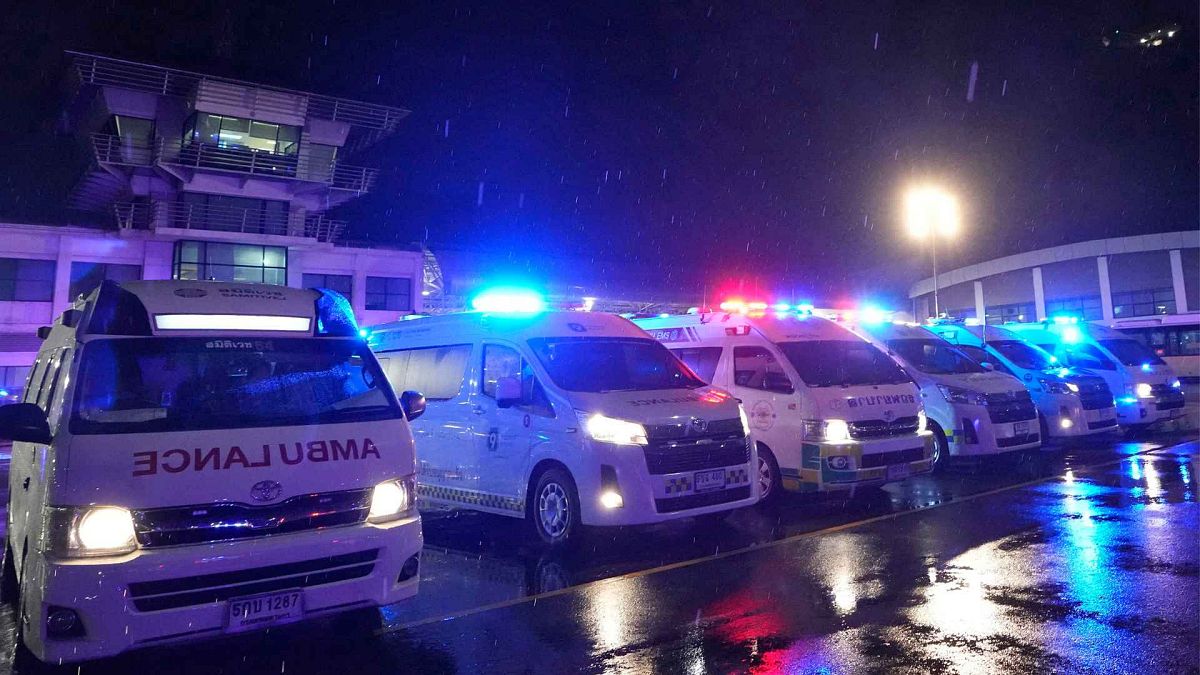It has been confirmed that a 73-year-old British man died during a flight from London to Singapore on Tuesday.
The plane was battered by severe turbulence, according to Singapore Airlines, and plummeted 1,800m in three minutes.
The man died of a heart attack and was travelling with his wife. She is in hospital but her condition has not been confirmed.
Seven passengers are said to be in a critical condition, with 53 other passengers reportedly injured along with one crew member.
The London-Singapore plane was diverted to Bangkok, where emergency crews rushed to help injured passengers amid stormy weather.
The Boeing 777-300ER, with 211 passengers and 18 crew members on board, landed safely in Thailand's capital, the airline said in a Facebook post.
Tracking data captured by FlightRadar24 and analysed by AP showed the flight suddenly and sharply pitching down over the course of three minutes.
The aircraft stayed at 9,500 metres for just under 10 minutes before rapidly descending and landing in Bangkok in around half an hour.
In a statement, Singapore's minister for transport Chee Hong Tat said: "I am deeply saddened to learn about the incident onboard Singapore Airlines flight SQ321 from London Heathrow to Singapore.
The plane had encountered severe turbulence en route and had to be diverted to Bangkok.
"Ministry of Transport, Singapore, Singapore Ministry of Foreign Affairs, Civil Aviation Authority of Singapore and Changi Airport officials as well as SIA staff are providing support to the affected passengers and their families."
"My deepest condolences to the family of the deceased," he added.
Pilots likely weren't aware of the upcoming turbulence
The flight had encountered what is known as clear-air turbulence. This does not show up on flight radars therefore pilots can not plan routes around it.
"Turbulence on flights can be caused by storms, mountains, and strong air currents called jet streams. In this last case, it is called clear-air turbulence, and it can be difficult to avoid because it doesn't show up on the weather radar in the flight deck.
A detailed analysis of the meteorological circumstances and the particular type of turbulence that caused today's fatality will take some time," says Dr Paul Williams, Professor of Atmospheric Science at University of Reading.
Is turbulence increasing due to climate change?
Emergency crews from Samitivej Srinakarin Hospital, located about 20 kilometres away from Suvarnabhumi Airport, were on site to transfer injured passengers from Flight SQ321 from Heathrow off the runway for treatment.
“Singapore Airlines offers its deepest condolences to the family of the deceased,” said the airline in a statement.
“We are working with the local authorities in Thailand to provide the necessary medical assistance, and sending a team to Bangkok to provide any additional assistance needed."
Images reportedly taken from within the plane posted on social media show damage to the plane's overhead lockers and oxygen masks hanging from the plane's roof.
Injuries from turbulence are rare but not impossible, according to aviation experts.
Researchers from the University of Reading have said that turbulence has increased in intensity, frequency and duration in various regions around the world, linking its increase to climate change.
"We now have strong evidence that turbulence is increasing because of climate change. We recently discovered that severe clear-air turbulence in the North Atlantic has increased by 55% since 1979.
Our latest future projections indicate a doubling or trebling of severe turbulence in the jet streams in the coming decades, if the climate continues to change as we expect," says report author Dr Paul Williams.


